2021 has been rife with challenges for small business leaders. Here are three top challenges and ways to navigate them.
For small businesses that made it through 2020, there was a lot riding on the new year. In February of 2021, almost half (49%) of small business leaders surveyed in Capterra’s 2021 Marketing Technology Survey named profitability as one of their top business goals. 38% said survival. We won’t lie to you: Times have been bleak.
As we wrap up 2021, a new set of challenges has been gracing headlines: The Great Resignation! Supply chain shortages! Mail delivery is slowing to a crawl, just in time for the holidays. And nearly one-third of small business owners were unable to pay rent in October, according to an Alignable survey.
The waters are murky, but we’re here to navigate them with you. In this article, we’ll discuss three of the top challenges small business leaders are facing right now, and we’ll also discuss ways to overcome those challenges so you can be a more informed, motivated, and optimistic leader for your small business heading into 2022.
Challenge #1: Maintaining productivity in a hybrid work model
As a small business owner, 2020 most likely added “pivoting” to your skill set. For many, pivoting means embracing the hybrid work model, allowing employees to work partially remote and partially on-site.
The hybrid work model is popular with employees because it allows for more flexibility and accounts for varied preferences. It’s no wonder that, according to Capterra’s 2021 Hybrid Work Survey, 70% of decision-makers at small businesses currently using a hybrid work model plan to stick with the model, even when other companies move operations back to the office full time.
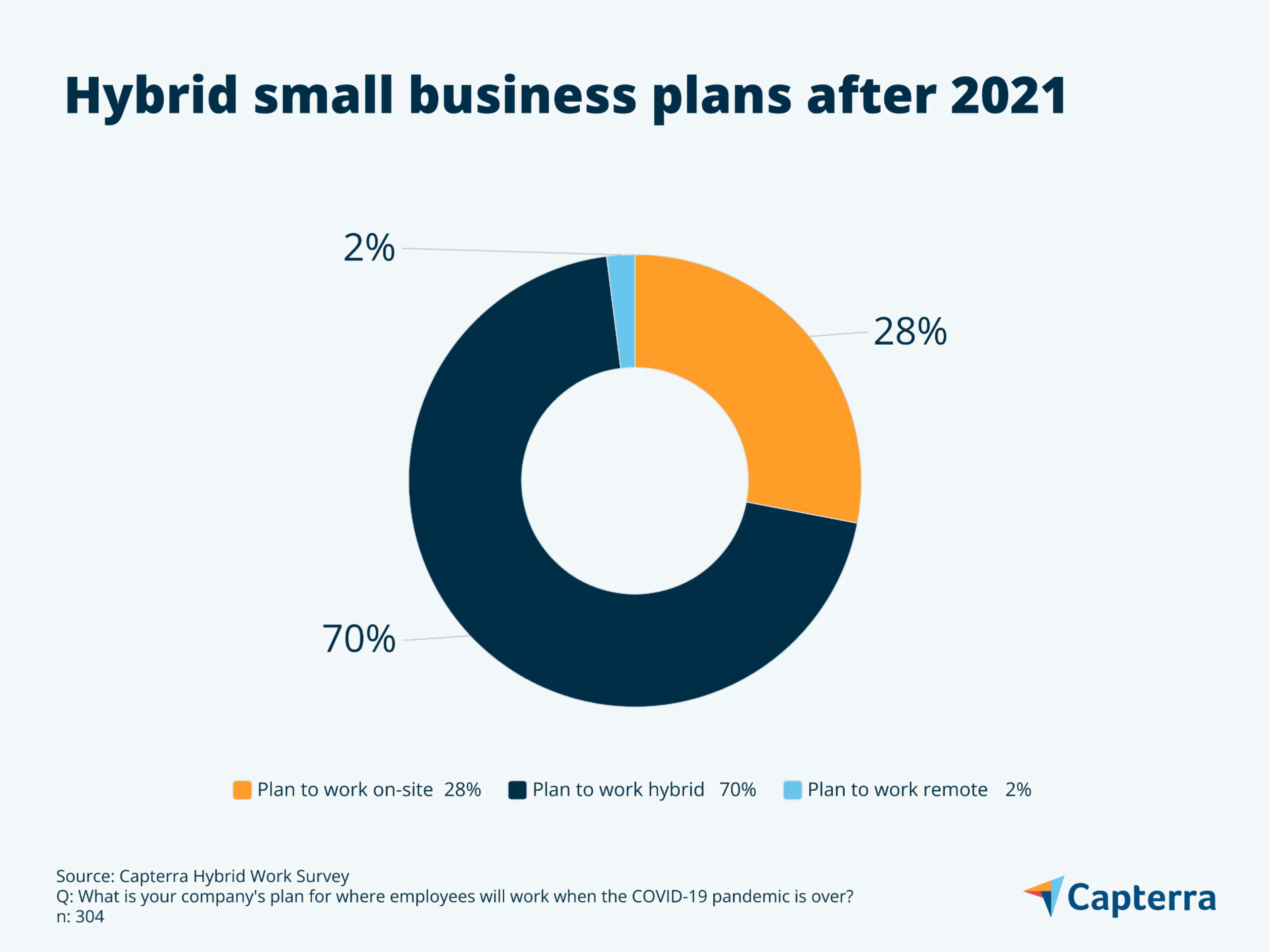
However, this flexibility can come with a price: Those same decision-makers at small hybrid businesses actually rated their performance slightly worse on average than those at 100% on-site or 100% remote across a variety of metrics.
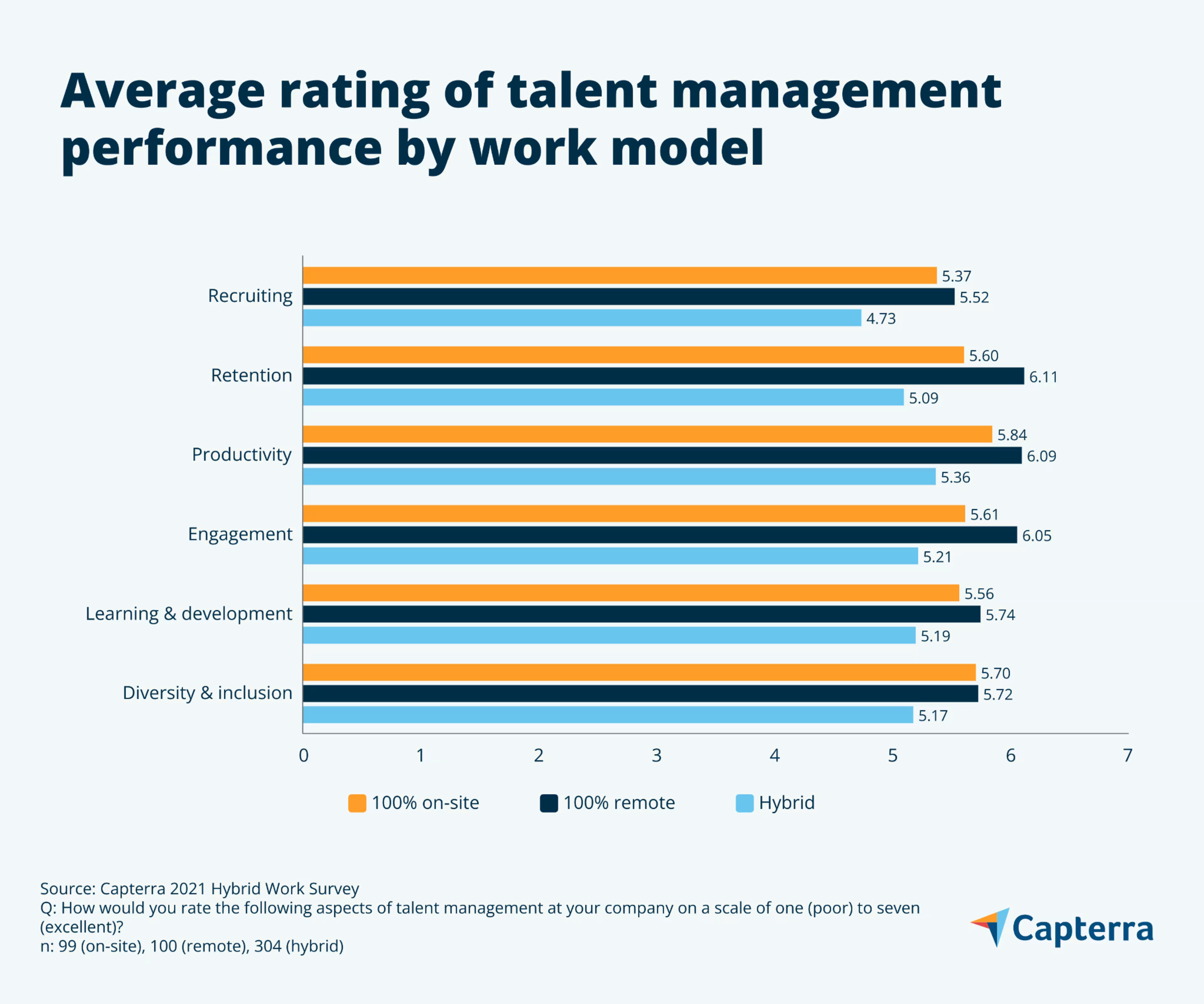
What’s keeping hybrid workplaces from performing at their full potential? Both decision-makers and their employees suggest that it’s an issue of productivity, among other factors.
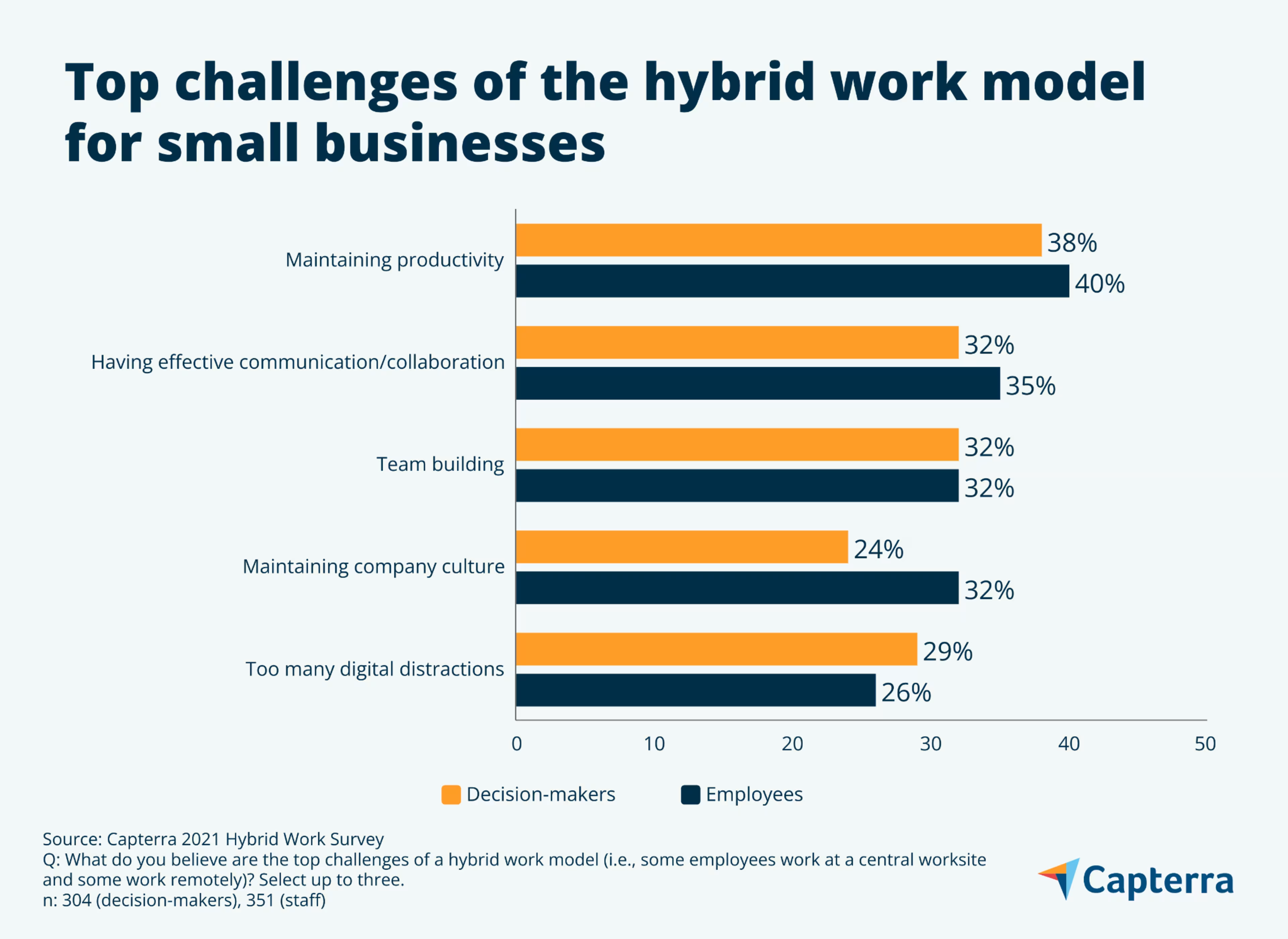
Gartner research points to the duplication of office-centric practices as one explanation for this dip in productivity. Put simply, when businesses allow employees to work from home part-time, they do so with the expectation that standard in-office practices will be replicated wherever employees are working. This means more meetings as well as tracking systems to ensure employees are staying on task.
Forcing standard office practices in non-office environments increases employee fatigue, which eventually leads to a lack of productivity. Here are some do’s and don’ts for a smooth transition to a flexible work model:
Do give employees time during the work day to handle personal obligations.
Don’t micromanage: Give employees deadlines, but allow them to work on their own time.
Do encourage employees to log off in the evenings and on weekends.
Don’t overschedule meetings or even casual virtual hangouts.
You don’t have to abandon your hybrid work model in order for your business to be successful. In fact, doing so might push your employees to look for work elsewhere, which leads us to our next top challenge faced by small businesses: staff turnover.
Check out our 2021 Shortlist for the highest-rated and most popular remote work software.
Challenge #2: Retaining employees (and hiring new ones)
A year and a half of introspection has emboldened people to leave jobs they don’t find fulfilling, and according to Forbes, it’s the result of a cultural uprising that’s been a long time coming. “The Great Resignation” has resulted in a huge demand for workers, and small business leaders are having a difficult time filling job vacancies.
How can small business leaders such as yourself be proactive, and avoid staff turnover? Gartner research offers both compensation-related and non-compensation-related tactics to retain talent (full content available to Gartner clients). Compensation-related tactics include increasing employees’ base salary and communicating how to grow one’s pay at the organization.
While compensation is certainly a top motivating factor in a worker’s decision to stay at a job, it isn’t everything. Non-compensation-related tactics include offering increased development opportunities, benefits such as retirement plans, and flexible work options such as the hybrid model we discussed previously. (Of course, you’ll want to keep our tips in mind to ensure a smooth transition to any new work model.)
Recruitment is worth discussing whether or not you’ve experienced turnover. In their 2021 Recruiting Strategy Survey, Capterra asked 300 professionals involved in recruiting efforts at U.S. businesses about the number of job openings for which they were actively recruiting and how long it’s taking to fill those openings. 43% of those surveyed said that there were more job openings than usual, and more than half (53%) said it’s taking more time than usual to find candidates for those jobs. When asked whether they agreed with the statement, “There are job openings at my employer I fear we’ll never be able to fill,” more than half (56%) somewhat or strongly agreed.
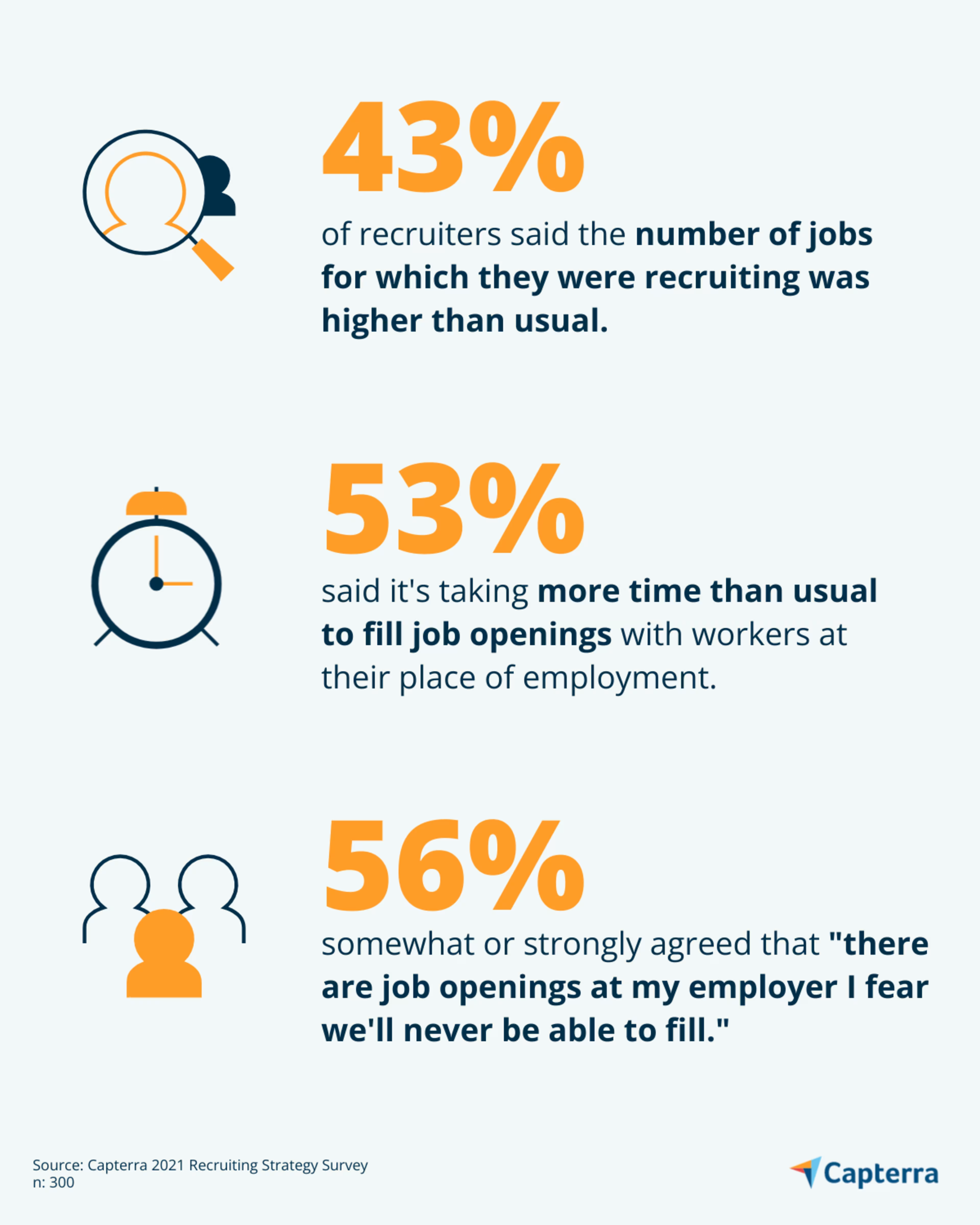
Needless to say, there’s a lot of anxiety around recruitment.
One way to increase your chances of filling job openings is to reevaluate—and then lower or remove—some job application requirements.
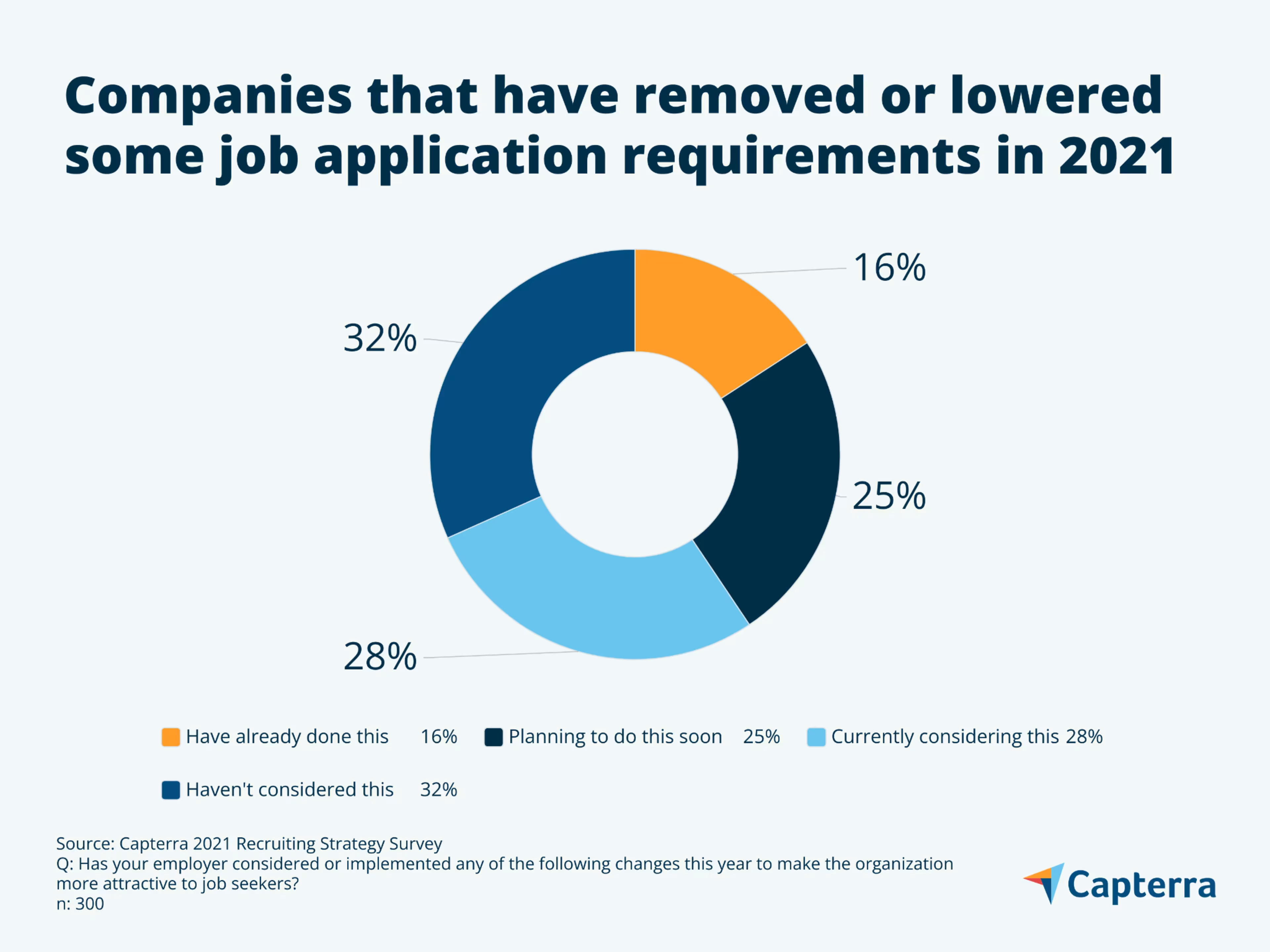
Despite being a low-effort way to get more applicants, only 16% of companies surveyed have lowered or removed job application requirements this year. Almost one-third (32%) haven’t even considered it.
Another easy way to get more applicants is to target those from underserved labor markets. According to our survey, only 21% of recruiters focused more on recruiting workers over 40 in 2021 than in previous years. The same percentage focused more on recruiting workers with disabilities this year.
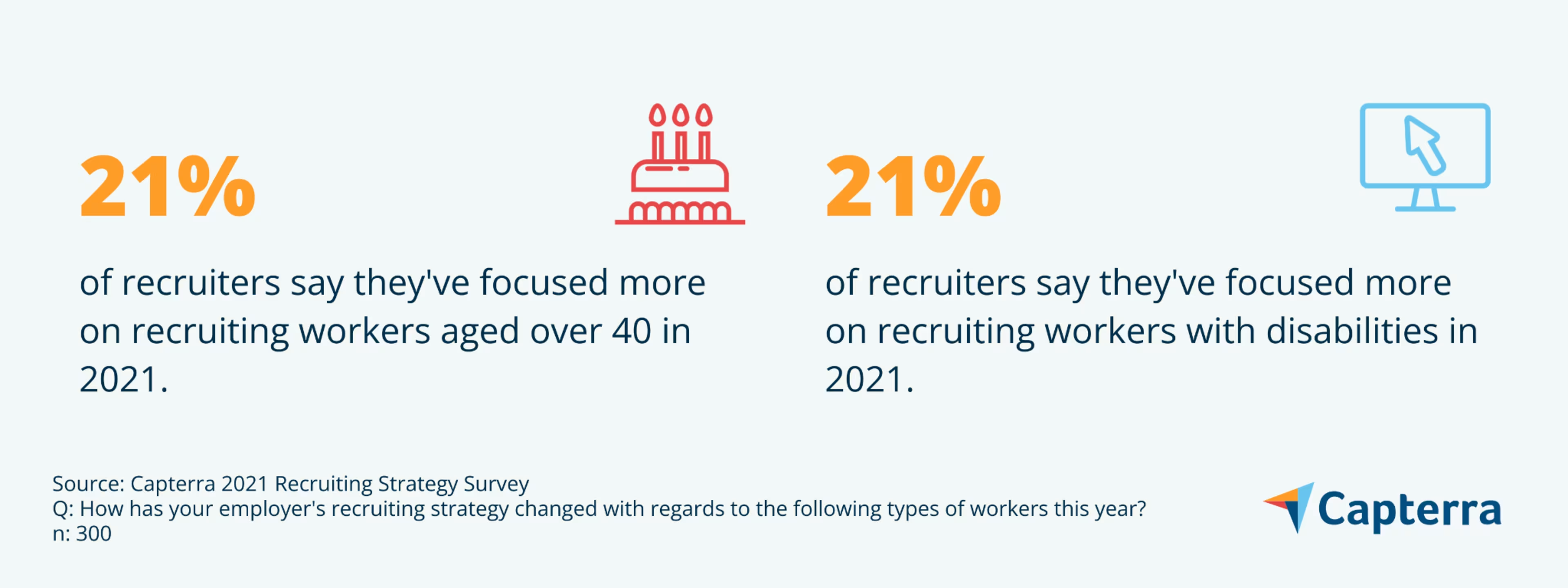
To reach these candidates, remove ageist and ableist language from job listings, and offer benefits that appeal to older workers. Invest in accommodations for workers who need them—they often cost nothing to implement, and their benefits extend to the rest of the workplace in the form of increased morale and productivity.
Check out our recruiting software directory to find the best recruiting software for your small business.
Looking to hire a recruiting agency for your business needs? Browse our list of companies in the following areas:
Challenge #3: Navigating supply chain disruptions
The COVID-19 pandemic has resulted in supply chain disruptions around the globe. According to a recent U.S. Census Small Business Pulse Survey, 45% of small businesses are having domestic supplier delays.
The shortage has spared no one. Restaurants are running low on to-go containers and cups. Breweries can’t package beer due to aluminum and glass shortages. Construction companies are navigating skyrocketing lumber costs amid increased demand for new houses.
What’s a small business leader to do? Make resilience your mantra. Gartner research offers three components for resilience when it comes to supply chain disruptions (full content available to Gartner clients): avoid, absorb, recover.
Avoid disruptions that will impact operations. Develop a contingency plan that lists potential scenarios, such as running out of a product, and actions to take if those scenarios happen, such as reaching out to backup suppliers.
Absorb the impact of disruptions. Set expectations by maintaining clear and consistent communication with customers. When something is out of stock or delayed, offer other solutions such as product alternatives or discounts.
Recover from disruptions when they impact operations. Brainstorm with your team when something goes awry, and make note of what ideas worked and what didn’t in case it happens again one day. For example, you might permanently implement an incentive program for customers to bring their own mugs to your coffee shop or growlers to your microbrewery.
Want more resources?
Small business leaders such as yourself have been thrown all sorts of curveballs over the past two years, but don’t worry—you aren’t alone. Our blog contains a wealth of information to help you make strategic decisions for your small business. Check out the following posts for more tips:
